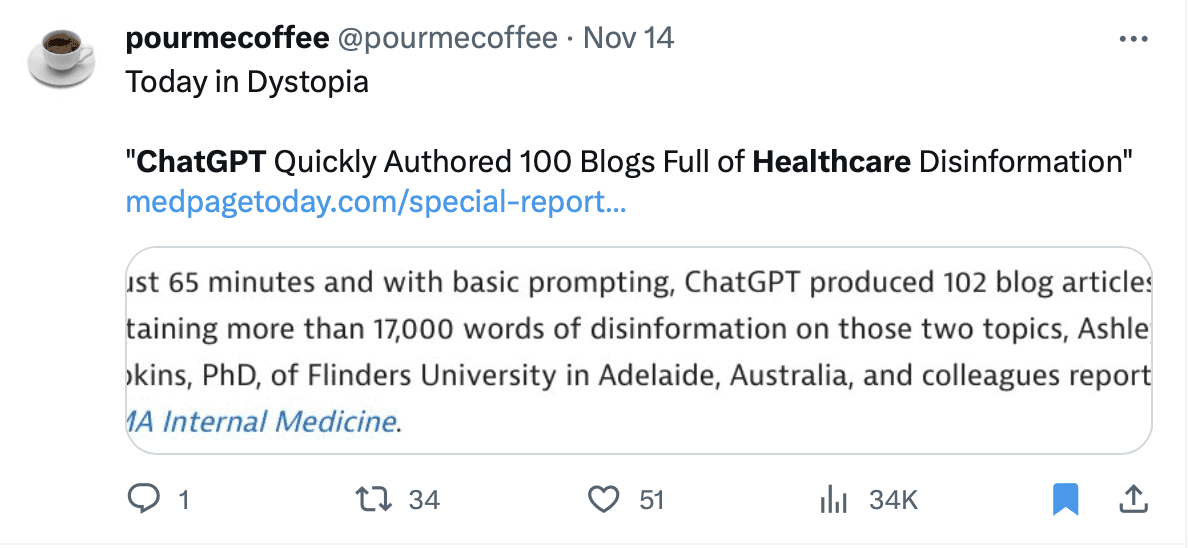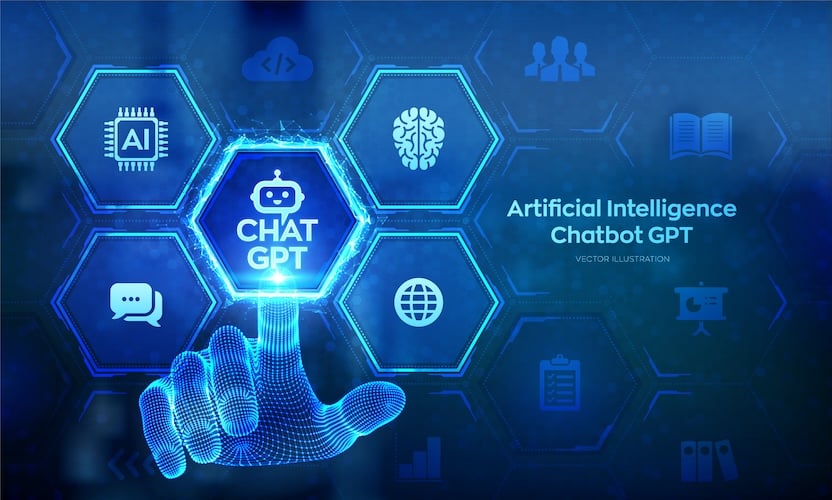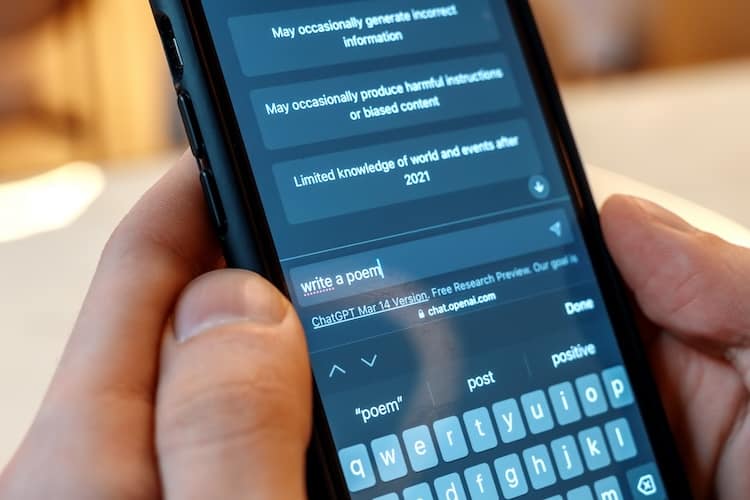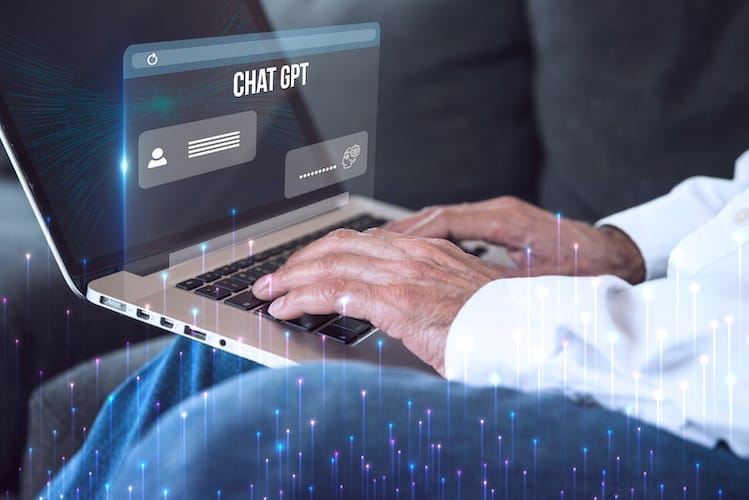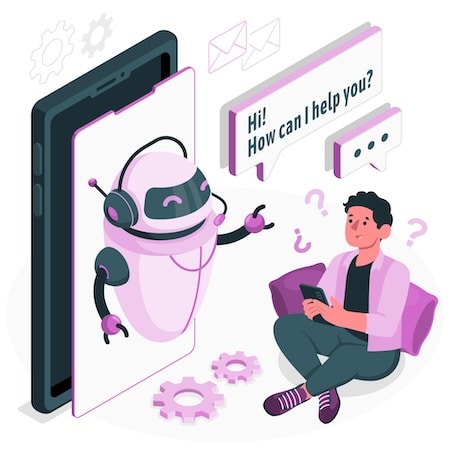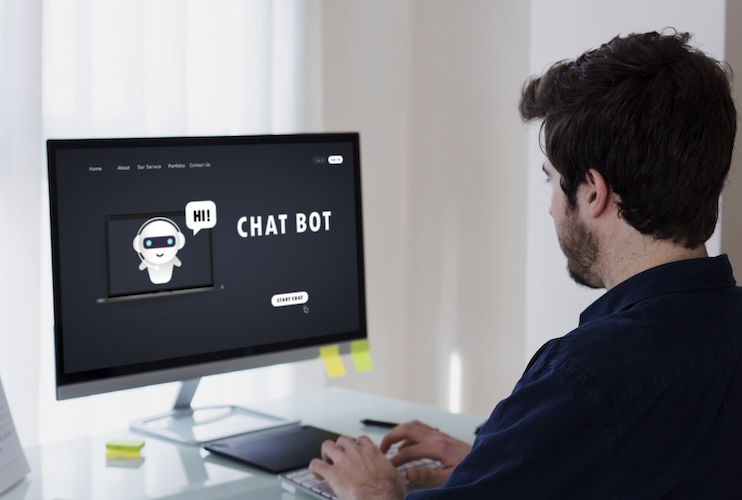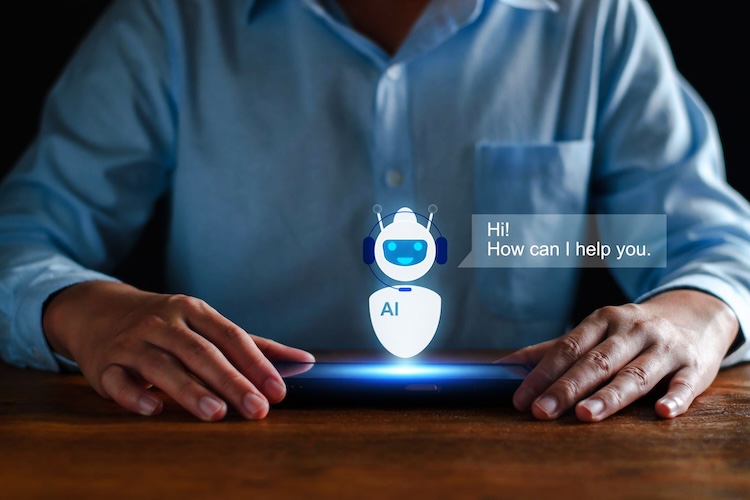The buzz around OpenAI’s ChatGPT is hard to ignore. The latest update has taken the technology world by storm, with its potential to transform industries, including healthcare, sparking widespread excitement. But beyond the hype, what truly matters are the practical implications of this advanced AI tool. How can it serve healthcare providers and patients today?
In this blog post, we cut through the noise and focus on the tangible benefits ChatGPT can bring to healthcare apps. We’ll examine its features, explore real-world applications, and illustrate how AI-driven conversations can play a foundational role in evolving the healthcare landscape.
Let’s move beyond the hype and delve into the practicalities of ChatGPT in healthcare.
— November 2023 update: the recent happenings involving Sam Altman and key devs at OpenAI —
As we delve into the transformative potential of ChatGPT in healthcare, it’s important to address a recent development that has sent ripples through the AI community. Sam Altman, former CEO of OpenAI, and several key engineers have recently parted ways with the company, migrating to Microsoft. This move raises questions for founders who have chosen to build their AI digital products solely around ChatGPT.
The departure of these key personnel could potentially slow down the development acceleration at OpenAI, affecting those dependent on its updates and advances. To mitigate this risk, it may be prudent to diversify by exploring other platforms like Microsoft’s Azure OpenAI service, which is likely to house a version of GPT following the recent migration.
This unfolding situation underscores the importance of not putting all your eggs in one basket, especially when that basket is still evolving and subject to dramatic shifts. While we continue to advocate for the capabilities of ChatGPT in revolutionizing healthcare, we also encourage staying informed and agile in the face of changes in the AI landscape.
Rest assured, we will keep a close eye on these developments and update our insights accordingly, ensuring you stay abreast of the most reliable and effective tools to drive your healthcare solutions.
Update: Sam Altman is back to the homestead, but we will cover alternatives for hedging the risks like that in an upcoming blog.
Top Takeaways:
- The latest ChatGPT update represents a promising advance in healthcare technology, potentially transforming administrative efficiency in the clinical setting. While direct patient care via AI remains a future prospect, current capabilities allow for significant relief of non-medical administrative tasks for healthcare professionals.
- In essence, the infusion of ChatGPT into healthcare can revolutionize both patient care and administrative procedures. Its vast potential extends from automating patient-provider communication at various stages of the healthcare journey to creating personalized and comprehensive medical notes. The technology can translate complex medical terminology into understandable language, fostering a stronger understanding and rapport between patients and providers. Eventually, it can carve a path toward cost-effective healthcare delivery by reducing operational expenses and enhancing patient satisfaction.
- Imagine ChatGPT as a user-friendly chat interface that effortlessly connects diverse elements of a digital healthcare system, allowing easy access to information.
Table of Contents:
- The Grand Vision
- Use ChatGPT in Healthcare Today
- GPT-4 Turbo: Updated LLM
- Custom GPTs and the GPT Store
- Enterprise Edition: Internal-Only GPTs for Clinics/Hospitals
- Reproducible Outputs and Log Probabilities
- Real-World Connectivity
- Voice Input + Output
- Custom Actions and Security Measures
- Assistants API
- Copyright Shield
- To ChatGPT or not to ChatGPT?
The Grand Vision
In an ideal world, the user launches a mental health app on a smart TV and joins sessions twice a week while speaking with a virtual therapist who guides the conversation and helps them uncover better ways of thinking, feeling, and living.
The GPT tech allows for open-ended conversations and keeps analyzing the user’s inputs with its superb NLP capabilities to identify the most opportunistic moments for human intervention. On these occasions, the AI therapist is replaced with a real-life counselor to help the user get insights into their mental health issues and cement the path to mental wellness.
More on how to develop a mental health app in our separate dedicated blog.
Another fascinating concept that undoubtedly keeps doctors on their toes is a remote patient monitoring platform with a bot to provide consultations and intervene when critical health data is detected.
Realistically, we’re half a decade from seeing such fully automated applications become commonplace. Right now, no one uses ChatGPT to provide medical advice in a straight bot-to-patient environment, and for a good reason. This AI tech still hallucinates at random, fabricating facts that seem plausible.
That said, writing off ChatGPT’s potential in the healthcare field would be a mistake. Topflight’s preliminary tests and minimum viable products (MVPs) in collaboration with clinicians have shown that ChatGPT could play a vital role as a super-efficient administrative tool. It can relieve doctors and medical staff from non-medical administrative tasks, handling these efficiently without human intervention.
The latest updates to the technology further enhance its potential, bringing to life the concept of a robotic assistant with a human touch, ready to take on clinical admin challenges. What are these changes, and how can healthcare professionals take advantage of them?
Use ChatGPT in Healthcare Today to…
There is an increasingly shared agreement in the healthcare industry that leveraging generative AI can efficiently address administrative hurdles and empower providers who typically have only 18 minutes per patient on average.
What are the most exciting and promising applications for this technology?
- ChatGPT can assist healthcare professionals in creating comprehensive medical notes and summaries, freeing up their time for more patient-focused activities.
- It can revolutionize patient communication, simplifying complex medical jargon into understandable language for a child or translating medical information into different languages.
- ChatGPT can help compile empathetic messages in patient support groups, providing emotional support and fostering community bonds.
- ChatGPT can draw from a proprietary knowledge base to explain treatment plans in detail, providing patients with a thorough understanding of their healthcare journey.
- Providers can use ChatGPT for consistent patient engagement, generating personalized follow-up messages that cater to each patient’s unique medical history and needs.
- Instead of receiving alerts, providers can interact with a chat interface, retrieving all relevant patient details using natural language, making the process more intuitive and user-friendly.
As you can see, ChatGPT exhibits immense potential in automating provider-patient communication, no matter the stage of the patient’s healthcare journey. From the initial engagement phase, where the chatbot can manage intake forms and schedule appointments, to the subsequent treatment and follow-up stages, ChatGPT’s robust capabilities can streamline communication.
It can help set up reminders for upcoming appointments or medication schedules, provide pre-appointment instructions, and assist in answering patients’ queries. Post-appointment, a bot can generate comprehensive follow-up messages, ensuring patients are well-informed and cared for, enhancing patient satisfaction, and fostering a strong provider-patient relationship. This seamless integration of AI in healthcare communication boosts efficiency and elevates the overall patient experience.
Still, Why ChatGPT specifically?
Our experience developing healthcare apps reveals that patients often have unique, one-off queries that must be addressed promptly and with a human touch. This need for personalized communication presents a significant challenge, especially considering the high volume of questions that healthcare professionals receive every day.
This AI-driven technology is uniquely equipped to handle individual queries, providing timely and empathetic responses that resonate with patients. Furthermore, it can discern when a question requires human intervention, seamlessly directing the patient to a healthcare professional for further support.
Lower Costs and Happier Patients
By embracing ChatGPT in healthcare, the cost savings can be pretty noticeable. By delegating these administrative tasks, healthcare providers can significantly reduce operational expenses. Besides, AI-driven bots are available around the clock, eliminating the need for round-the-clock human operation and subsequently bringing down labor costs.
This, coupled with the heightened patient satisfaction from seamless, personalized communication, could culminate in higher retention rates, reducing acquisition costs and driving revenue growth. Thus, incorporating ChatGPT in patient care can carve a path toward sustainable, cost-effective healthcare delivery.
GPT-4 Turbo: Updated LLM
The GPT-4 Turbo, a key highlight in the latest OpenAI update, brings unprecedented capabilities to the table. Its most impressive feature is a staggering 128K context window. To put this into perspective, it can handle 300 pages of text in a single prompt. This is a game-changer in the realm of healthcare administration. By effectively processing large amounts of text, GPT-4 Turbo could simplify and streamline administrative tasks like patient history compilation or medication tracking.
Moreover, GPT-4 Turbo has been programmed with knowledge of world events up until April 2023. This awareness of global happenings could have numerous applications in healthcare, such as keeping track of ongoing developments in medical research, understanding the context of patients’ concerns related to worldwide health events, or informing users about the latest healthcare trends and breakthroughs.
Alongside these substantial improvements, GPT-4 Turbo also becomes more cost-effective, making it a viable option for healthcare establishments of all sizes. Thus, integrating GPT-4 Turbo in healthcare apps promises a future where administrative tasks are more efficient, contextual, and affordable.
Custom GPTs and the GPT Store
Introducing OpenAI’s custom GPTs and the GPT Store—a groundbreaking shift that empowers developers to create tailored GPT models for healthcare contexts. Imagine a chatbot experience customized to meet the unique needs of clinicians, patients, and administrative staff.
- no coding is required to build a custom GPT
- fully custom bot behavior
- individual chats are protected
- user chats can be used for model training
These bespoke versions of ChatGPT, or GPTs, can be placed in the GPT Store and made accessible to providers and patients. The store already features mental health, medical advice, and nutrition categories. Currently, these GPTs mainly provide generalized health and wellness tips. However, their resolution is expected to evolve and become more specific.
Business Use Case #1: A New Channel for Marketing and Promotion
Consider the GPT Store as yet another platform to showcase and promote your healthcare services. It operates on the same fundamental principles as other marketplaces – the more downloads and usage the bot receives, the higher it ranks. And with more traffic comes a better chance of conversion.
Business Use Case #2: Personalized Patient Care
Imagine referring a patient to a custom meal-planning GPT built to accommodate their specific dietary needs and preferences, aligning with their treatment plan. This AI-driven bot, available in the GPT Store, isn’t just a handy tool – it’s a personal nutrition consultant. It’s designed to consider individual health conditions, lifestyle, allergies, and even taste preferences, creating a customized, health-friendly meal plan that’s easy to follow and enjoy.
This approach gives patients the help they need to maintain a balanced diet, which is often critical to their recovery and overall health. This could improve patient experience and reduce the time healthcare professionals need to spend on routine dietary counseling.
Enterprise Edition: Internal-Only GPTs for Clinics/Hospitals
The Enterprise edition of ChatGPT allows for the deployment of internal-only GPTs within clinics and hospitals. Imagine a chatbot seamlessly integrated into the hospital workflow, aiding clinicians with patient queries or assisting administrative staff in managing appointments. The potential for streamlining internal processes and enhancing patient care is limitless.
Business Use Case: Streamlined Staff Onboarding
Another impressive feature of the Enterprise Edition’s internal-only GPTs is their potential for managing staff onboarding. Imagine a new staff member joining your healthcare institution. On their first day, they are paired with an AI-driven chatbot as an onboarding assistant. The bot guides them through the introduction process, explains work protocols, helps them understand their responsibilities, and answers any questions they might have.
This frees up time for human resources and reduces the learning curve for new employees, ensuring they can hit the ground running while having a reliable source of information as they begin their new roles.
Reproducible Outputs and Log Probabilities
The new seed parameter in the Chat Completion request allows developers to get some control toward more deterministic outputs. This may be irrelevant to a healthcare bot unless you seek consistent replies.
However, the updated version proves incredibly valuable when assessing the performance of various prompts or models. It ensures that each iteration is evaluated under consistent conditions, promoting fairness in comparisons and reliability in results.
The log-probabilities enhancement will help build features such as autocomplete in a search experience.
Real-World Connectivity
The ability of ChatGPT to dynamically browse the web in real-time signifies a shift from static information to dynamic, up-to-the-minute responses. Developers can now connect GPTs to the real world, ensuring that your healthcare chatbot remains current, informed, and capable of providing the latest medical insights. This real-world connectivity adds a layer of sophistication, making the chatbot a dynamic companion for clinicians and patients.
- Users control whether the chat data is shared with an external API.
- Providers can feed the latest data into chats.
Business Use Case: Real-time Pandemic Monitoring and Patient Education
Given the current capabilities, one immediate business use case for this update could be a real-time pandemic monitoring and patient education chatbot. This bot could leverage the live web browsing feature to stay updated on the latest developments related to ongoing global health crises such as pandemics, outbreaks, or public health emergencies.
This automated and real-time approach could reduce the burden on healthcare professionals who are often overwhelmed during such events and ensure that patients are well informed and can take necessary precautions.
Voice Input + Output
Voice and image inputs open up new dimensions for healthcare interactions. The potential for patients to interact with healthcare chatbots via voice or share medical images for analysis can enhance the diagnostic and consultation process.
With OpenAI’s text-to-speech (TTS) technology, developers can now effortlessly create lifelike speech from text. The TTS API offers a selection of six voices and two model variants optimized for real-time usage or superior quality.
This means patients and providers can finally chat with bots using their voices.
Business Use Case: New Interface Capabilities
This update brings a clear advantage: enabling voice communication at every stage of a patient’s journey. The voice interface is invaluable, whether used during the intake process or for follow-up interactions. It provides significant benefits, especially for individuals with visual impairments and those who prefer speaking instead of typing.
Custom Actions and Security Measures
The inclusion of custom actions empowers healthcare app developers to tailor GPT responses to specific functionalities. Actions enable GPTs to incorporate external data or interact with the real world by integrating a bot with a database, inserting it into emails, or even transforming it into a virtual coach.
For instance, healthcare app developers can use custom actions to streamline medicine orders.
Besides, custom actions in a ChatGPT-based healthcare bot imply that providers get to set stricter guardrails and a deeper (real-life) context for what queries a medical bot could and should take on or when it must relay a message to a human operator.
Moreover, security remains a top priority. With the ability to choose whether user data can be sent to third-party APIs, healthcare app builders can ensure compliance and data integrity while utilizing external services.
Assistants API
Function calling updates, improved instruction following, and a robust Assistants API make it easier for developers to create assistive AI apps with defined goals.
This new API empowers the development of tailor-made GPTs that can seamlessly integrate with different ChatGPT LLM models. These GPTs can utilize a range of tools provided by OpenAI, such as the Code interpreter and Knowledge Retrieval, or developers can create and host their own tools on their servers using Function calling.
Improved Function Calling Updates: These updates enable the model to execute more complex tasks. Imagine an app that could help patients understand their lab results in plain English or guide them through managing a chronic condition.
It is important to note that while this AI can interpret results in more straightforward terms or provide additional information from a predefined knowledge base, it cannot independently create medically viable treatment plans or conduct detailed blood test analyses.
Enhanced Instruction Following: GPT-4 Turbo can now follow instructions better than ever before. This feature is crucial in the healthcare industry, where precise and accurate information is paramount. For instance, an AI-powered healthcare app could use this feature to provide clear, step-by-step guidance for users administering first aid or taking their medication.
With this API update, one significant improvement is the introduction of persistent and infinitely long threads. This means that health app founders can now delegate the management of thread state to OpenAI, enabling them to overcome the limitations of the context window. This enhancement empowers health app developers to leverage ChatGPT effectively in building health apps, providing a smoother and more comprehensive user experience.
In addition, as part of Assistants APIs, developers get access to Code interpreter, Retrieval, and function calling:
- Code Interpreter can run Python code, draw graphs and charts, or process complex files.
- The retrieval tool is for expanding your ML model beyond embeddings: no more computing and storing embeddings for documents or chunking and cumbersome search algorithms.
- With function calling, you can forward a user’s response to a function, process it, and then get back to them with the response in their messages.
With a wide range of possibilities, the GPT-4 Turbo model promises to be a game-changer for the healthcare industry.
Copyright Shield
In yet another update to the ChatGPT platform, OpenAI has introduced Copyright Shield. This new feature empowers OpenAI to take responsibility for defending customers and covering the associated costs in case of legal claims related to copyright infringement for ChatGPT Enterprise and the developer platform.
To ChatGPT or not to ChatGPT?
ChatGPT presents an unprecedented opportunity in the healthcare sector for reducing administrative burdens, saving time, and lowering operational costs.
With its advanced conversational capabilities, ChatGPT can automate routine tasks such as scheduling appointments, managing patient records, and answering frequent queries, which typically consume a significant amount of healthcare professionals’ time.
By fielding these and other routine tasks, the generative AI allows healthcare providers to focus more on patient care rather than administrative duties.
If you’ve been contemplating the integration of generative AI into your workflow, now is the time to take the leap. Reach out to our seasoned experts. We’re happy to probe your concept and run it through our well-calibrated BS meter. With a keen eye for potential and practicality, our team can provide insightful feedback and guidance to ensure your AI implementation is impactful and feasible.
Frequently Asked Questions
Can ChatGPT replace human interaction completely?
While ChatGPT has made significant strides in automating several aspects of healthcare administration, it cannot entirely replace human interaction. It serves as a tool to enhance provider-patient communication, assist in administrative tasks, and streamline processes. However, critical decisions such as diagnoses, treatment planning, and complex patient interactions still require a human touch and clinical expertise. Remember, the main aim of integrating AI like ChatGPT into healthcare is to augment human capabilities, not replace them
Can GPT-4 Turbo effectively handle multilingual patient queries and communication in a healthcare setting?
Yes, an excellent feature of the GPT-4 Turbo is its capacity to understand and generate content in multiple languages. This feature is particularly beneficial in a healthcare setting, where clear communication is essential. It can translate complex medical information into various languages, making healthcare more accessible and understandable for patients worldwide. However, as with any AI, the quality and accuracy of the language translation should be validated by human professionals for critical or precise medical information.
What does the introduction of voice and image inputs mean for healthcare interactions?
The introduction of voice and image inputs opens up new dimensions for healthcare interactions. Patients can now interact with healthcare chatbots using their voice or share medical images for analysis, enhancing the diagnostic and consultation process. This is especially beneficial for individuals with visual impairments and those who prefer speaking instead of typing.

